I had been travelling for over four hours by now but it was still a long way to Singapore. It was a one hour and a half bus ride from the new KLIA LCC-T (Low Cost Carrier Terminal) to Kuala Lumpur. I reached KL Sentral Station at about 10:15 p.m. and took another bus from there to the Pudu Raya Bus Station. From there, I took a bus to Singapore which was about six hours. For dinner, I had nasi lemak on the plane and mee rebus at the stopover midway between KL and Singapore. This is the second time I've done this border crossing to Singapore so it wasn't much of a hassle. I got there at 4 a.m. after 12 hours of non-stop travel!
As soon as I got down, I gave my SSEAYP friend Leon Ong a ring. Hehe! He had thought I was arriving the next day but he went straight to fetch me at the Golden Mile Food Centre where the bus dropped us off. And of course, since we were in Singapore, we went straight for food. Hehe!
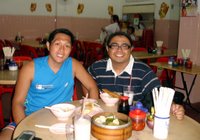 Breakfast was soya... tau huay and soya milk. I hope I got the spelling right but that is taho to us Filipinos, although the Singapore version does not have syrup or sago, just boiled peanuts. After breakfast, we went straight to Leon's flat and it was off to bed for me.
Breakfast was soya... tau huay and soya milk. I hope I got the spelling right but that is taho to us Filipinos, although the Singapore version does not have syrup or sago, just boiled peanuts. After breakfast, we went straight to Leon's flat and it was off to bed for me.
Obviously, I slept the whole morning. I had been to Singapore several times before so I've seen most of the sights. Things you shouldn't miss include walking tours around the colonial district or even better, a boat ride on the Singapore River which comes complete with a narrated recording of the history of the former British colony and the buildings you pass by; and trips to Sentosa Island, Clarke Quay and Boat Quay and of course, Chinatown and Little India. In the evenings, there is the Night Safari at Singapore Zoo.
Anyway, I had breakfast take two when I woke up prepared by Leon's mom since he was at work. After lunch, we bought my bus ticket back to KL. Driving around Singapore is indeed refreshing. It's an urban jungle. Not the concrete one but literally, the island is very green with trees! You have modern buildings right beside virgin forests. I hope Mayor Atienza learns to follow the Singapore example. He should stop cutting trees at the Arroceros Forest Park and should even start planting trees all over Manila! I also wonder where Bayani Fernando got this idea that trees cause slow traffic. I still remember that Katipunan incident where he wanted to get rid of all those big trees. I heard Singapore even imports big trees for their downtown areas.
 Check out the photo of the East Coast Parkway (ECP). In the middle island, you have trees and bougainvillea shrubs in full bloom. At the sides, you also have trees and flowering shrubs. All pedestrian overpasses and flyovers have hanging bougainvillea shrubs on either side and ivy crawling up the concrete posts. It saves up on paint since the green ivy does the trick of covering the concrete. I laud Bayani for the cadena de amor but I think he should first make ivy crawl up the MRT posts then let the cadena vines to grow over them so that even if the cadena vines dry out which happens quite often, it's still green underneath. Maybe the NLEX and SLEX could also learn a lesson or two from the ECP.
Check out the photo of the East Coast Parkway (ECP). In the middle island, you have trees and bougainvillea shrubs in full bloom. At the sides, you also have trees and flowering shrubs. All pedestrian overpasses and flyovers have hanging bougainvillea shrubs on either side and ivy crawling up the concrete posts. It saves up on paint since the green ivy does the trick of covering the concrete. I laud Bayani for the cadena de amor but I think he should first make ivy crawl up the MRT posts then let the cadena vines to grow over them so that even if the cadena vines dry out which happens quite often, it's still green underneath. Maybe the NLEX and SLEX could also learn a lesson or two from the ECP.
Another thing is the urban planning is nothing but excellent! You feel there is so much space despite the fact that land is scarce in Singapore. In the Philippines, it's the opposite. We have so much land but everything feels so cramped up. Sigh! Can our mayors please create forest parks in their jurisdictions. We need trees to breathe! At the same time, Singapore was able to eradicate its slums thanks to the Housing and Development Board (HDB). Maybe Gawad Kalinga and the HUDCC could learn a thing or two from the HDB.
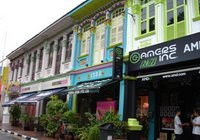 And all over Singapore, you had centuries old buildings and shop houses freshly painted. Hello again Mayor Atienza, please see how Singapore does it. They don't go around demolishing old buildings like the Jai Alai, YMCA and San Lazaro or plan trashing the Army Navy Club and Elks Buildings. In fact doing that in both Singapore and Malaysia is a crime. The trend in most old cities all over the globe today is urban renewal and renaissance or "re" which stands for restoring, regenerating, rebuilding, reviving, resurrecting these old urban centers, not demolishing old buildings like Mayor Atienza does.
And all over Singapore, you had centuries old buildings and shop houses freshly painted. Hello again Mayor Atienza, please see how Singapore does it. They don't go around demolishing old buildings like the Jai Alai, YMCA and San Lazaro or plan trashing the Army Navy Club and Elks Buildings. In fact doing that in both Singapore and Malaysia is a crime. The trend in most old cities all over the globe today is urban renewal and renaissance or "re" which stands for restoring, regenerating, rebuilding, reviving, resurrecting these old urban centers, not demolishing old buildings like Mayor Atienza does.
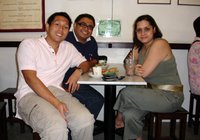 Later in the afternoon, we met up with Dawn Pereira, another SSEAYP batchmate and went for some kaya roti at the Ya Kun Kaya Toast along China Street. Yummy! Hehe! I had a Horlicks drink to go with it. I wonder why those Horlicks candies are no longer available in the Philippines. I used to love them as a kid.
Later in the afternoon, we met up with Dawn Pereira, another SSEAYP batchmate and went for some kaya roti at the Ya Kun Kaya Toast along China Street. Yummy! Hehe! I had a Horlicks drink to go with it. I wonder why those Horlicks candies are no longer available in the Philippines. I used to love them as a kid.
 After that snack, it was off for early dinner. I really consider Singapore and Malaysia as food havens since there is so much to eat thanks to the mixture of many cultures which includes Chinese, Malay and Indian. The photo of the hawker centre above is in Ang Mo Kio. It is however a regular Singapore scene which you can find almost everywhere. I definitely had to have some char kuey teow which is a fried noodle dish with scallops. But aside from that, we also ordered oh-luak which was oyster omellette with wansuy and green onions, and chendol for dessert.
After that snack, it was off for early dinner. I really consider Singapore and Malaysia as food havens since there is so much to eat thanks to the mixture of many cultures which includes Chinese, Malay and Indian. The photo of the hawker centre above is in Ang Mo Kio. It is however a regular Singapore scene which you can find almost everywhere. I definitely had to have some char kuey teow which is a fried noodle dish with scallops. But aside from that, we also ordered oh-luak which was oyster omellette with wansuy and green onions, and chendol for dessert.
 Then is was off to somewhere I haven't been to before. The best place to take a photo of the Singapore skyline is a bridge which is rarely visited by tourists. You park at Suntec City and it's a short walk from there. Wow! Great view!
Then is was off to somewhere I haven't been to before. The best place to take a photo of the Singapore skyline is a bridge which is rarely visited by tourists. You park at Suntec City and it's a short walk from there. Wow! Great view!
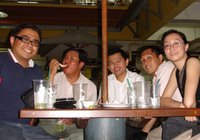 And we weren't done eating yet since we met up with Singapore PYs Vincent and Francis. I had satay which is the Malay version of our barbecue, ice-cold sugar cane juice, chai tow kway the Chinese version of carrot cake and roti john. We were done eating at 10:30 p.m. since I had to catch my bus back to KL which was the last bus for the night. The first one in the morning was at 7:30 a.m. and I would be late for my flight if I took that one. So it was less than 24 hours in Singapore but it was most worth it.
And we weren't done eating yet since we met up with Singapore PYs Vincent and Francis. I had satay which is the Malay version of our barbecue, ice-cold sugar cane juice, chai tow kway the Chinese version of carrot cake and roti john. We were done eating at 10:30 p.m. since I had to catch my bus back to KL which was the last bus for the night. The first one in the morning was at 7:30 a.m. and I would be late for my flight if I took that one. So it was less than 24 hours in Singapore but it was most worth it.
I arrived in KL at 4 a.m. Tired from all that travelling, I got myself a room at a backpackers place for less than US$10 which was good enough for a few hours of sleep and a shower before I left for the airport. Zzzzzzzz!
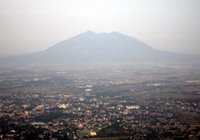 As I mentioned in my earlier entry, it's fun seeing the things down below from a bird's eye view. From the DMIA, you see a different landscape. The most prominent of these attractions is Mount Arayat which towers over the central plains of Luzon. I was able to recognize the City of San Fernando as well. From there, you also see the towns at the Pampanga River delta and Manila Bay.
As I mentioned in my earlier entry, it's fun seeing the things down below from a bird's eye view. From the DMIA, you see a different landscape. The most prominent of these attractions is Mount Arayat which towers over the central plains of Luzon. I was able to recognize the City of San Fernando as well. From there, you also see the towns at the Pampanga River delta and Manila Bay.
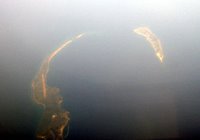 Then Corregidor came into view, like a little tadpole swimming at the mouth of the historic bay. Since we've touched on the island, might as well talk about it. A few years back, I got to take an alternative route to Corregidor, faster at that. We're all familiar with those fastcrafts which leave from the CCP Complex. They charge quite a hefty amount if I remember it right. But if you are vacationing in the Subic or Morong area, you might want to consider visiting the island since it is only 30 minutes by pump boat from a certain barangay in Mariveles.
Then Corregidor came into view, like a little tadpole swimming at the mouth of the historic bay. Since we've touched on the island, might as well talk about it. A few years back, I got to take an alternative route to Corregidor, faster at that. We're all familiar with those fastcrafts which leave from the CCP Complex. They charge quite a hefty amount if I remember it right. But if you are vacationing in the Subic or Morong area, you might want to consider visiting the island since it is only 30 minutes by pump boat from a certain barangay in Mariveles.
 At that time, I think the boat ride costed us PHP1500 total. Imagine the savings if there were more of us. I and a brod, Felix Lopez dared another brod Ryan Tan that we could meet up with him and his family in Corregidor. He thought we were joking since we were in Bataan, hours away from the port in Manila. Hehe! So to make the long story short, we were able to reach the island just as they were about to depart. The good thing about pump boats is that you had your own departure time.
At that time, I think the boat ride costed us PHP1500 total. Imagine the savings if there were more of us. I and a brod, Felix Lopez dared another brod Ryan Tan that we could meet up with him and his family in Corregidor. He thought we were joking since we were in Bataan, hours away from the port in Manila. Hehe! So to make the long story short, we were able to reach the island just as they were about to depart. The good thing about pump boats is that you had your own departure time.
 So after Ryan left, we had our own tour of the island. I contacted Col. Art Matibag, head of the Corregidor Foundation, who was kind enough to lend us a vehicle around the island. I had met Col. Matibag when we were actively pushing for the preservation of the San Fernando Train Station which is a very important Second World War site.
So after Ryan left, we had our own tour of the island. I contacted Col. Art Matibag, head of the Corregidor Foundation, who was kind enough to lend us a vehicle around the island. I had met Col. Matibag when we were actively pushing for the preservation of the San Fernando Train Station which is a very important Second World War site.
Corregidor is actually part of Cavite City although it is closer to Bataan. The other island you see at the tip is Caballo Island. Known as "the rock," it was host to Fort Mills during the American colonial period which is when most of the artilery was placed there. Today it is one of the most important Second World War shrines in the country having been the site of one of the bloodiest battles of the war, the Battle of Corregidor.

 Some of the more popular sites on the island are the batteries, the Corregidor War Memorial, the Corregidor Lighhouse which is one of the few remaining Spanish structures left standing, and Lorca Dock where MacArthur uttered his famous lines, "I shall return!"
Some of the more popular sites on the island are the batteries, the Corregidor War Memorial, the Corregidor Lighhouse which is one of the few remaining Spanish structures left standing, and Lorca Dock where MacArthur uttered his famous lines, "I shall return!"
Anyway, we flew down the coast of Cavite and Zambales, then over the island of Mindoro. Sigh! And we all wonder why we have all these landslides. The forests were all gone. Just a few patches of green. I hope the DENR focuses on protection of what's left as well as reforestation.
From there, we made a right turn toward continental Asia. Didn't see much since it was dark. We arrived in Kuala Lumpur at about 8:30 p.m. after a four hour flight.
I will be flying in a while to KL from the Diosdado Macapagal International Airport in Clark. This is my transition post of sorts. Hehe! From backpacking in the country, it's time to visit our Southeast Asian neighbors and see what they are doing right. The plan is, from KL, I will take a bus to Singapore and back, after which I will take an AirAsia flight to Phnom Penh in Cambodia. From there, I travel by bus to Siem Reap to visit the temples of Angkor.
From Siem Reap, it's another bus to Bangkok in Thailand from where I will take another bus to Vientiane in Laos. A few hours north is the UNESCO World Heritage town of Luang Prabang. Then its back to Bangkok where I take an AirAsia flight back to KL and back to Clark. Let's see how things go.
I purchased the Lonely Planet book Southeast Asia on a Shoestring, and from the data I read, we can see why the Philippines is doing badly with regard to visitor arrivals. To Secretary Durano and our policy makers in the DOT, the advertising is good but unless we sit down with the tourism industry players and work out ways to lower costs of traveling here in the country, the funds spent for advertising would be a waste. At the same time, target backpackers. They are the reason behind the bustling tourism industry in Southeast Asia.
Please see the data below of the average daily budget spent traveling in Southeast Asian countries. I'm not surprised that Brunei Darussalam is at the top, and so is Singapore since the cost of living there is quite high. I'm also not surprised that East Timor is on top since they do not have the necessary tourism infrastructure to bring costs down since they are just a new nation. But the Philippines having the same cost as Singapore?! Hmmm, now Mr. Secretary, that is something we have to consider.
Budget per day (US$)
Brunei Darussalam: 30 to 50
East Timor: 25 to 25
Philippines: 25
Singapore: 25
Vietnam: 23
Indonesia: 15 to 30
Cambodia: 15
Myanmar: 12 to 20
Malaysia: 12
Thailand: 11 to 15
Laos: 10
 Breakfast was soya... tau huay and soya milk. I hope I got the spelling right but that is taho to us Filipinos, although the Singapore version does not have syrup or sago, just boiled peanuts. After breakfast, we went straight to Leon's flat and it was off to bed for me.
Breakfast was soya... tau huay and soya milk. I hope I got the spelling right but that is taho to us Filipinos, although the Singapore version does not have syrup or sago, just boiled peanuts. After breakfast, we went straight to Leon's flat and it was off to bed for me. Check out the photo of the East Coast Parkway (ECP). In the middle island, you have trees and bougainvillea shrubs in full bloom. At the sides, you also have trees and flowering shrubs. All pedestrian overpasses and flyovers have hanging bougainvillea shrubs on either side and ivy crawling up the concrete posts. It saves up on paint since the green ivy does the trick of covering the concrete. I laud Bayani for the cadena de amor but I think he should first make ivy crawl up the MRT posts then let the cadena vines to grow over them so that even if the cadena vines dry out which happens quite often, it's still green underneath. Maybe the NLEX and SLEX could also learn a lesson or two from the ECP.
Check out the photo of the East Coast Parkway (ECP). In the middle island, you have trees and bougainvillea shrubs in full bloom. At the sides, you also have trees and flowering shrubs. All pedestrian overpasses and flyovers have hanging bougainvillea shrubs on either side and ivy crawling up the concrete posts. It saves up on paint since the green ivy does the trick of covering the concrete. I laud Bayani for the cadena de amor but I think he should first make ivy crawl up the MRT posts then let the cadena vines to grow over them so that even if the cadena vines dry out which happens quite often, it's still green underneath. Maybe the NLEX and SLEX could also learn a lesson or two from the ECP. And all over Singapore, you had centuries old buildings and shop houses freshly painted. Hello again Mayor Atienza, please see how Singapore does it. They don't go around demolishing old buildings like the Jai Alai, YMCA and San Lazaro or plan trashing the Army Navy Club and Elks Buildings. In fact doing that in both Singapore and Malaysia is a crime. The trend in most old cities all over the globe today is urban renewal and renaissance or "re" which stands for restoring, regenerating, rebuilding, reviving, resurrecting these old urban centers, not demolishing old buildings like Mayor Atienza does.
And all over Singapore, you had centuries old buildings and shop houses freshly painted. Hello again Mayor Atienza, please see how Singapore does it. They don't go around demolishing old buildings like the Jai Alai, YMCA and San Lazaro or plan trashing the Army Navy Club and Elks Buildings. In fact doing that in both Singapore and Malaysia is a crime. The trend in most old cities all over the globe today is urban renewal and renaissance or "re" which stands for restoring, regenerating, rebuilding, reviving, resurrecting these old urban centers, not demolishing old buildings like Mayor Atienza does. Later in the afternoon, we met up with Dawn Pereira, another SSEAYP batchmate and went for some kaya roti at the Ya Kun Kaya Toast along China Street. Yummy! Hehe! I had a Horlicks drink to go with it. I wonder why those Horlicks candies are no longer available in the Philippines. I used to love them as a kid.
Later in the afternoon, we met up with Dawn Pereira, another SSEAYP batchmate and went for some kaya roti at the Ya Kun Kaya Toast along China Street. Yummy! Hehe! I had a Horlicks drink to go with it. I wonder why those Horlicks candies are no longer available in the Philippines. I used to love them as a kid. After that snack, it was off for early dinner. I really consider Singapore and Malaysia as food havens since there is so much to eat thanks to the mixture of many cultures which includes Chinese, Malay and Indian. The photo of the hawker centre above is in Ang Mo Kio. It is however a regular Singapore scene which you can find almost everywhere. I definitely had to have some char kuey teow which is a fried noodle dish with scallops. But aside from that, we also ordered oh-luak which was oyster omellette with wansuy and green onions, and chendol for dessert.
After that snack, it was off for early dinner. I really consider Singapore and Malaysia as food havens since there is so much to eat thanks to the mixture of many cultures which includes Chinese, Malay and Indian. The photo of the hawker centre above is in Ang Mo Kio. It is however a regular Singapore scene which you can find almost everywhere. I definitely had to have some char kuey teow which is a fried noodle dish with scallops. But aside from that, we also ordered oh-luak which was oyster omellette with wansuy and green onions, and chendol for dessert. Then is was off to somewhere I haven't been to before. The best place to take a photo of the Singapore skyline is a bridge which is rarely visited by tourists. You park at Suntec City and it's a short walk from there. Wow! Great view!
Then is was off to somewhere I haven't been to before. The best place to take a photo of the Singapore skyline is a bridge which is rarely visited by tourists. You park at Suntec City and it's a short walk from there. Wow! Great view! And we weren't done eating yet since we met up with Singapore PYs Vincent and Francis. I had satay which is the Malay version of our barbecue, ice-cold sugar cane juice, chai tow kway the Chinese version of carrot cake and roti john. We were done eating at 10:30 p.m. since I had to catch my bus back to KL which was the last bus for the night. The first one in the morning was at 7:30 a.m. and I would be late for my flight if I took that one. So it was less than 24 hours in Singapore but it was most worth it.
And we weren't done eating yet since we met up with Singapore PYs Vincent and Francis. I had satay which is the Malay version of our barbecue, ice-cold sugar cane juice, chai tow kway the Chinese version of carrot cake and roti john. We were done eating at 10:30 p.m. since I had to catch my bus back to KL which was the last bus for the night. The first one in the morning was at 7:30 a.m. and I would be late for my flight if I took that one. So it was less than 24 hours in Singapore but it was most worth it.





